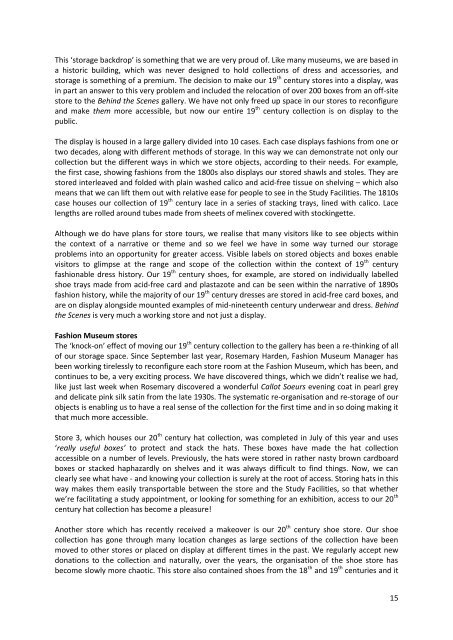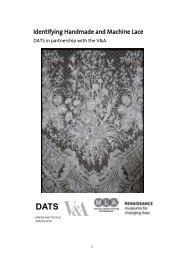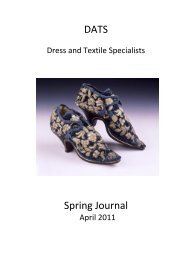Spring 2012 - Dress and Textile Specialists
Spring 2012 - Dress and Textile Specialists
Spring 2012 - Dress and Textile Specialists
Create successful ePaper yourself
Turn your PDF publications into a flip-book with our unique Google optimized e-Paper software.
This ‘storage backdrop’ is something that we are very proud of. Like many museums, we are based in<br />
a historic building, which was never designed to hold collections of dress <strong>and</strong> accessories, <strong>and</strong><br />
storage is something of a premium. The decision to make our 19 th century stores into a display, was<br />
in part an answer to this very problem <strong>and</strong> included the relocation of over 200 boxes from an off-site<br />
store to the Behind the Scenes gallery. We have not only freed up space in our stores to reconfigure<br />
<strong>and</strong> make them more accessible, but now our entire 19 th century collection is on display to the<br />
public.<br />
The display is housed in a large gallery divided into 10 cases. Each case displays fashions from one or<br />
two decades, along with different methods of storage. In this way we can demonstrate not only our<br />
collection but the different ways in which we store objects, according to their needs. For example,<br />
the first case, showing fashions from the 1800s also displays our stored shawls <strong>and</strong> stoles. They are<br />
stored interleaved <strong>and</strong> folded with plain washed calico <strong>and</strong> acid-free tissue on shelving – which also<br />
means that we can lift them out with relative ease for people to see in the Study Facilities. The 1810s<br />
case houses our collection of 19 th century lace in a series of stacking trays, lined with calico. Lace<br />
lengths are rolled around tubes made from sheets of melinex covered with stockingette.<br />
Although we do have plans for store tours, we realise that many visitors like to see objects within<br />
the context of a narrative or theme <strong>and</strong> so we feel we have in some way turned our storage<br />
problems into an opportunity for greater access. Visible labels on stored objects <strong>and</strong> boxes enable<br />
visitors to glimpse at the range <strong>and</strong> scope of the collection within the context of 19 th century<br />
fashionable dress history. Our 19 th century shoes, for example, are stored on individually labelled<br />
shoe trays made from acid-free card <strong>and</strong> plastazote <strong>and</strong> can be seen within the narrative of 1890s<br />
fashion history, while the majority of our 19 th century dresses are stored in acid-free card boxes, <strong>and</strong><br />
are on display alongside mounted examples of mid-nineteenth century underwear <strong>and</strong> dress. Behind<br />
the Scenes is very much a working store <strong>and</strong> not just a display.<br />
Fashion Museum stores<br />
The ‘knock-on’ effect of moving our 19 th century collection to the gallery has been a re-thinking of all<br />
of our storage space. Since September last year, Rosemary Harden, Fashion Museum Manager has<br />
been working tirelessly to reconfigure each store room at the Fashion Museum, which has been, <strong>and</strong><br />
continues to be, a very exciting process. We have discovered things, which we didn’t realise we had,<br />
like just last week when Rosemary discovered a wonderful Callot Soeurs evening coat in pearl grey<br />
<strong>and</strong> delicate pink silk satin from the late 1930s. The systematic re-organisation <strong>and</strong> re-storage of our<br />
objects is enabling us to have a real sense of the collection for the first time <strong>and</strong> in so doing making it<br />
that much more accessible.<br />
Store 3, which houses our 20 th century hat collection, was completed in July of this year <strong>and</strong> uses<br />
‘really useful boxes’ to protect <strong>and</strong> stack the hats. These boxes have made the hat collection<br />
accessible on a number of levels. Previously, the hats were stored in rather nasty brown cardboard<br />
boxes or stacked haphazardly on shelves <strong>and</strong> it was always difficult to find things. Now, we can<br />
clearly see what have - <strong>and</strong> knowing your collection is surely at the root of access. Storing hats in this<br />
way makes them easily transportable between the store <strong>and</strong> the Study Facilities, so that whether<br />
we’re facilitating a study appointment, or looking for something for an exhibition, access to our 20 th<br />
century hat collection has become a pleasure!<br />
Another store which has recently received a makeover is our 20 th century shoe store. Our shoe<br />
collection has gone through many location changes as large sections of the collection have been<br />
moved to other stores or placed on display at different times in the past. We regularly accept new<br />
donations to the collection <strong>and</strong> naturally, over the years, the organisation of the shoe store has<br />
become slowly more chaotic. This store also contained shoes from the 18 th <strong>and</strong> 19 th centuries <strong>and</strong> it<br />
15





